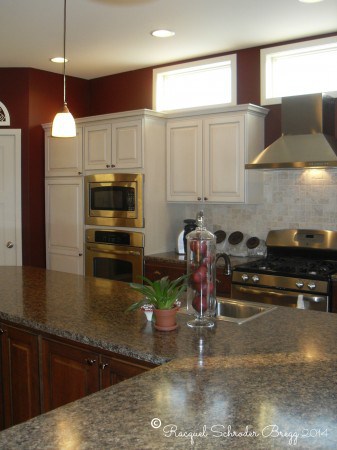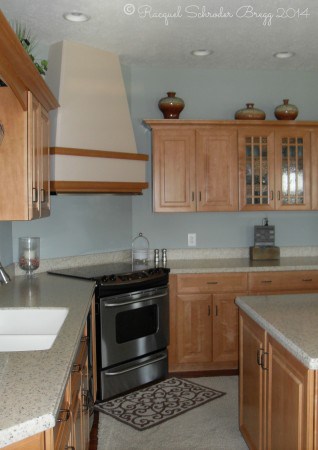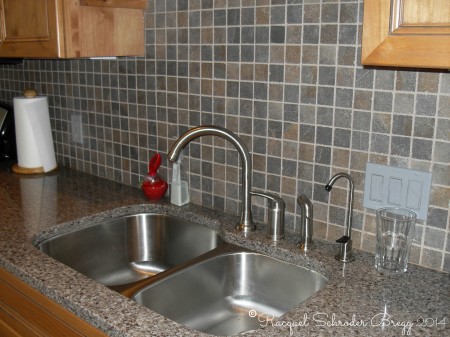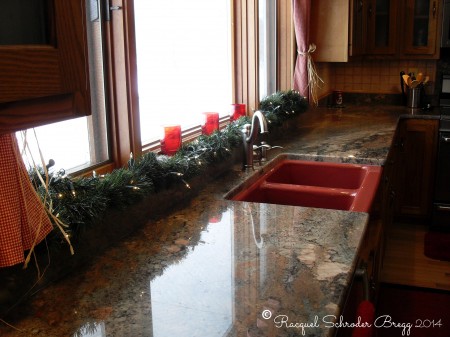Purchasing new countertops for your home, whether you’re building or remodeling, is one of the biggest home improvement decisions especially with so many Countertop Materials available. Countertops come in every shape, size, color, and material under the sun it seems. No matter the look you are trying to achieve in your kitchen or bathroom, there is a countertop material to fit.
Choosing Countertop Materials
If you’re building or remodeling your kitchen, you’ve probably realized by now that countertops for your home can be very affordable or more expensive than you ever dreamed possible! It can be very overwhelming to try to understand the basic differences between the different countertop materials available. The following is a brief breakdown to help you make an educated decision when it comes to countertop options.
Laminate
First up is plastic laminate countertops. Your mother or grandmother probably called these tops “Formica”. Formica is just one manufacturer of laminate tops (like Kleenex is one manufacturer of tissue). Laminate is generally the most affordable of countertop materials. Plastic laminate is just that – plastic. It is made up of several layers of paper and fiber with a plastic finish. The color or pattern of the laminate countertop is paper thin meaning that it does not go all the way through the thickness of the top. Laminate is applied to a high density fiberboard to create a 1 1/2″ thick countertop. There are hundreds of colors and patterns available in finishes that are smooth and matte as well as textured to look like real stone. While the colors and patterns seem almost limitless, there are some restrictions to the shapes and sizes laminate tops can be manufactured in. Laminate tops are fairly easy to install as a DIY project or most contractors can install them at a very reasonable rate. The material for laminate tops is ordered when cabinetry is ordered and cut to fit when cabinets are installed, making turn around for tops rather quick. If you’re remodeling, the dimensions of your existing tops and cabinets can be used to order new tops.
Pros of Laminate Countertops
- huge selection of colors and finishes
- very affordable
- affordable or DIY installation
- several edge details available
- lightweight
- beautiful
- integrated backsplash
- fairly quick turn around
- consistent coloring
Cons of Laminate Counterops
- finish is not repairable – scratches or chips can not be repaired
- sizes are limited to 60″ wide x 144″ long in most cases (seams will be required for anything larger)
- if choosing a rounded edge, tops that are not single straight pieces will generally require a noticeable seam
- undermount sinks are only available in limited sink styles, with certain countertop edge details, and are VERY costly
- limited warranties
- they are not heat or scratch resistant
Solid Surface
Most people have heard of Corian. This is one popular brand of solid surface yet there are many manufacturers of this ever popular countertop material. Solid surface is generally a 100% acrylic material (acrylic = plastic). There are many colors and patterns available in solid surface and the material is the same all the way through. There are three qualities that make solid surface really appealing. 1. The material can be fused together to create nearly invisible seams at corners and sinks can be integrated for a seamless appearance. 2. The material can be shaped into unusual arcs, angles, and others shapes with inconspicuous seams. 3. The material is 100% renewable and repairable – scratches can be buffed out, deep scratches and chips can be repaired, large chips or burns can be cut out and new material can be fused in place to renew the top. Solid surface typically carries a 10 year to limited lifetime warranty depending on the brand. However, for the warranty to be valid, the material must be fabricated (built) and installed by a brand specific certified installer. This means that installation can be costly and it is definitely not a DIY project. Solid surface tops typically require a template for manufacturing. When your cabinets are completely installed, a team will come and measure your cabinetry and build a wood template of your tops. This insures tops fit snug against walls and fit your cabinetry perfectly. Once templates are made, turn around is typically 2-3 weeks.
Pros of Solid Surface Countertops
- 100% renewable and repairable
- great warranty
- no limit to size or shape
- integrated “seamless” sinks
- inconspicuous seams
- beautiful color selection
- many edge details available
- integrated backsplash
- pricing includes installation
- perfect fit
- anti-microbial
- does not require sealing
- consistent coloring
Cons of Solid Surface Countertops
- more limited (than laminate) color and finish options
- not a DIY project
- more expensive than laminate (but price includes installation)
- longer lead times
- is not heat or scratch resistant
Engineered Stone
Engineered stone is made up of approximately 97% real stone (or Quartz) that is crushed then put back together with a resin material. The resin allows for a variety of colors and patterns. Because the product is made up of 97% real stone, it is very durable and has many of the same characteristics of natural stone. It is extremely scratch resistant but is not as heat resistant or impact resistant as real stone. Sinks can be installed as both drop in our undermount. The looks is luxurious and rich. The material comes in limited sizes so seams are a must when tops exceed certain widths or lengths. Seams are also a must in most tops that are not a simple straight run. Tops can be cut into most desired shapes and many edge details are available. Like solid surface, engineered stone tops must be templated and installed by a brand specific certified installer.
Pros of Engineered Stone Countertops
- Many edge details available
- large variety of patterns and colors
- tops can be cut to most desired shapes
- small chips and scratches are repairable
- very scratch resistant
- sinks can be installed in an undermount application
- very smooth finish
- anti-microbial
- does not require sealing
- consistent coloring
- excellent warranty
Cons of Engineered Stone Countertops
- very costly (but cost does include installation)
- not heat resistant
- requires seams for tops over a certain size or certain shapes
- longer lead times
Natural Stone (Granite)
Natural stone is an incredible countertop option. The large pieces of granite are cut from the Earth and the natural beauty of the colors and patterns are truly breathtaking. Countertops made from natural stone are the most durable tops available. They are completely heat resistant and scratch resistant. In fact, your knife will dull before the top will scratch. The sizes are limited by slabs that the mines are able to cut from the Earth. Natural stone can have a great deal of variation from slab to slab and many colors can often have unexpected splashes of color. It’s always wise to visit warehouse to select your specific pieces of stone because of this variation. Whenever possible, “sister slabs’ should be selected for a project requiring more than one sheet of stone. Granite is cut like a loaf of bread, so the slabs that are cut from different sections will not necessarily match or look the same. Sister slabs are pieces cut next to one another. Granite is a natural product with small openings similar to your skin. These openings or pores can allow bacteria to penetrate if the stone is not sealed properly. Granite is typically installed by a fabricator that works with solid surface and engineered stone and usually requires templating. In some cases, you may be able to purchase pieces of stone to cut and install yourself if you have appropriate tools. Like engineered stone, the material comes in limited sizes so seams are a must when tops exceed certain widths or lengths. Seams are also a must in most tops that are not a simple straight run. Tops can be cut into most desired shapes and many edge details are available.
Pros of Natural Stone Tops
- 100% heat resistant
- 100% scratch resistant
- natural occurring colors and patterns
- many edge details available
- tops can be cut to most desired shapes
- very smooth finish
- sinks can be installed in an undermount application
- warranty is for workmanship rather than the actual stone in most cases
Cons of Natural Stone Tops
- longer lead times
- more costly (cost includes installation)
- color and pattern can be unpredictable
- tops must be properly sealed on a regular basis
Countertop materials can be mixed and matched in the same space. Many homeowners will choose laminate tops for the main part of the kitchen and a granite or engineered stone for an island. Colors and patterns can also be mixed to give more visual appeal in certain spaces. While it can be an overwhelming decision, knowing as much as you can about the different materials will help you choose a material that best fits your family and your lifestyle.
What questions do you have about countertop materials? Are you stuck trying to decide on color or do you have questions or concerns about durability?
More Home Decor Ideas
Installing Cabinet Hardware
Tips for Painting Walls Like a Pro
5 Tips for Perfectly Painted Furniture
How to Decorate Furniture with Decals
How to Make a Fabric Strip Valence
How to Convert Recessed Lighting to Pendant Lighting






Liz says
What do you know about paint on counter tops? We will be trying this in a few months and the ones i have seen look nice! Wondering if you have ever worked with it.
Racquel says
I’ve seen laminate tops painted on several occasions. There are many products on the market for painting a laminate that will give the tops a “granite look” and will give tops a textured look and feel. The problem is that most of these products have not been on the market for a long time to really be “time tested”. I’m not sure how they stand up to wear and cleaning. Definitely check reviews and such before deciding on a specific brand! I too would like to try this so please share your experience once you give it a try!